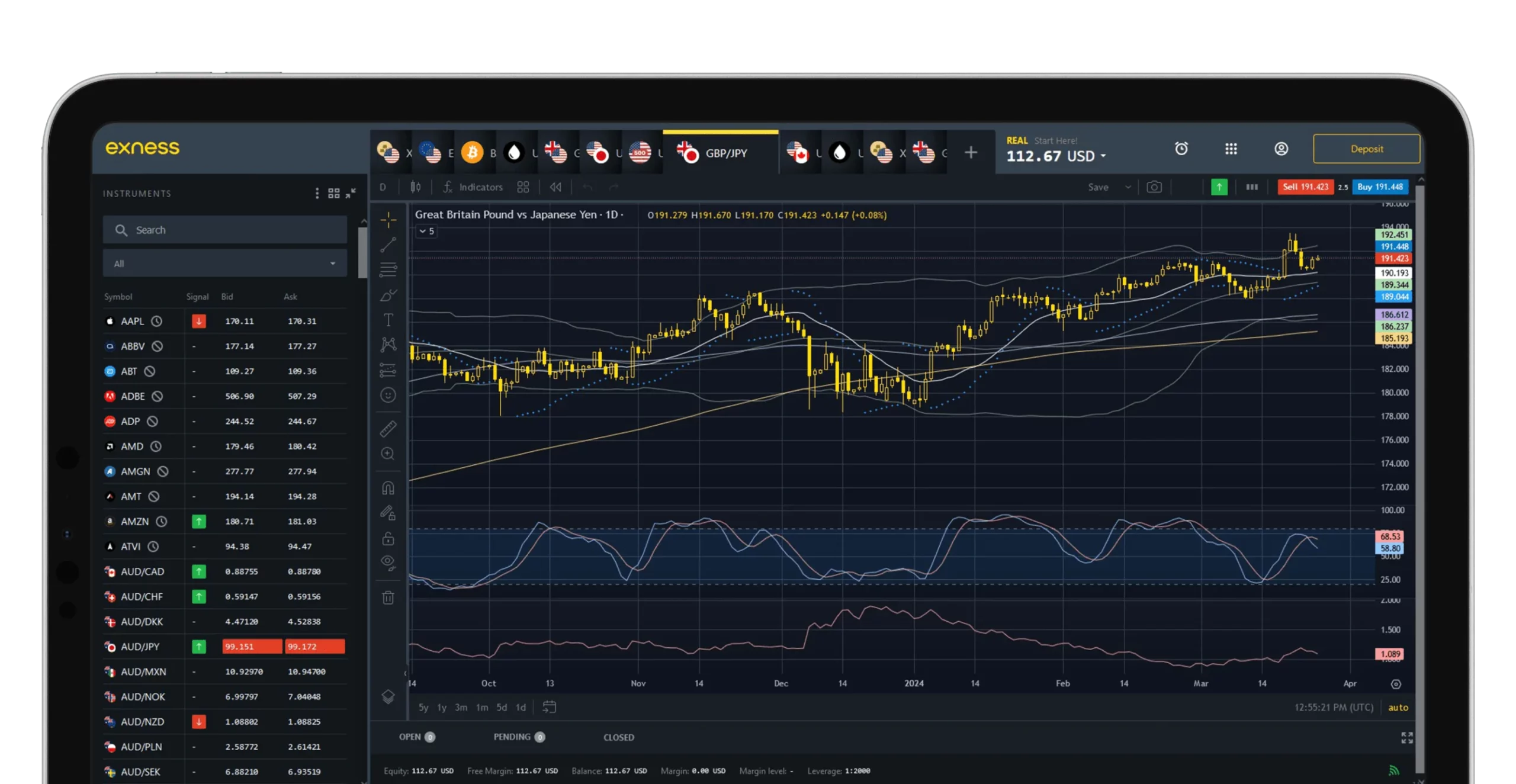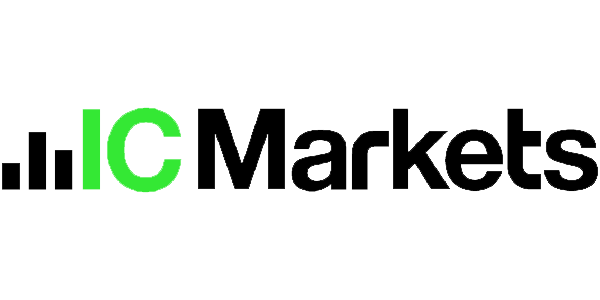- Top High Leverage CFD Brokers for 2025
- Understanding Leverage in CFD Trading
- Benefits and Risks of High Leverage Trading
- Regional Leverage Regulations
- How to Choose a High Leverage CFD Broker
- Risk Management When Trading with High Leverage
- How to Get Started with a High Leverage Broker
- Common High Leverage Trading Strategies
- Our Testing Methodology
- Comparison Table of Top High Leverage CFD Brokers
- Conclusion
- Additional Resources
- Frequently Asked Questions
Top High Leverage CFD Brokers for 2025
Here are the best high leverage brokers based on my testing:
| Commision | Instruments | Min Dep | Leverage | Platforms | ||
|---|---|---|---|---|---|---|
| No commission fees, cost through spreads | Forex Crypto Metals Indices Commodities | $10 | Up to 1:2000 | MT4 MT5 Web Terminal Mobile App | ||
| $3-$7 per lot | Forex Indices Commodities Stocks Futures | $200 | Up to 1:500 | MT4 MT5 cTrader TradingView Web Mobile | ||
| $0-$3 per lot | Forex Indices Commodities Stocks | $50 | Up to 1:500 | MT4 MT5 PRO Trader (TradingView) AppTrader WebTrader Mobile apps | ||
| $0-$4 per lot | Forex Indices Commodities Stocks Cryptocurrencies | $10 | Up to 1:3000 | MT4 MT5 FXTMTrader Mobile apps | ||
| $0 | Forex Indices Commodities Stocks Cryptocurrencies | $100 | Up to 1:400 | MT4 MT5 AvaTradeGO WebTrader Mobile apps | ||
| $0 | Forex Indices Commodities Stocks Cryptocurrencies | $100 | Up to 1:30 | Proprietary platform Web Mobile |
Exness (Best Overall)
Exness offers leverage up to 1:2000. This means $100 can control a $200,000 position.
Their spreads are very low. EUR/USD often has spreads below 0.1 pips.
Their platform works well even during market crashes. They have good negative balance protection. You won’t lose more than you deposit.
Small traders get good leverage too, not just big accounts.
The downside: Their highest leverage isn’t available in the UK or Australia due to regulations.
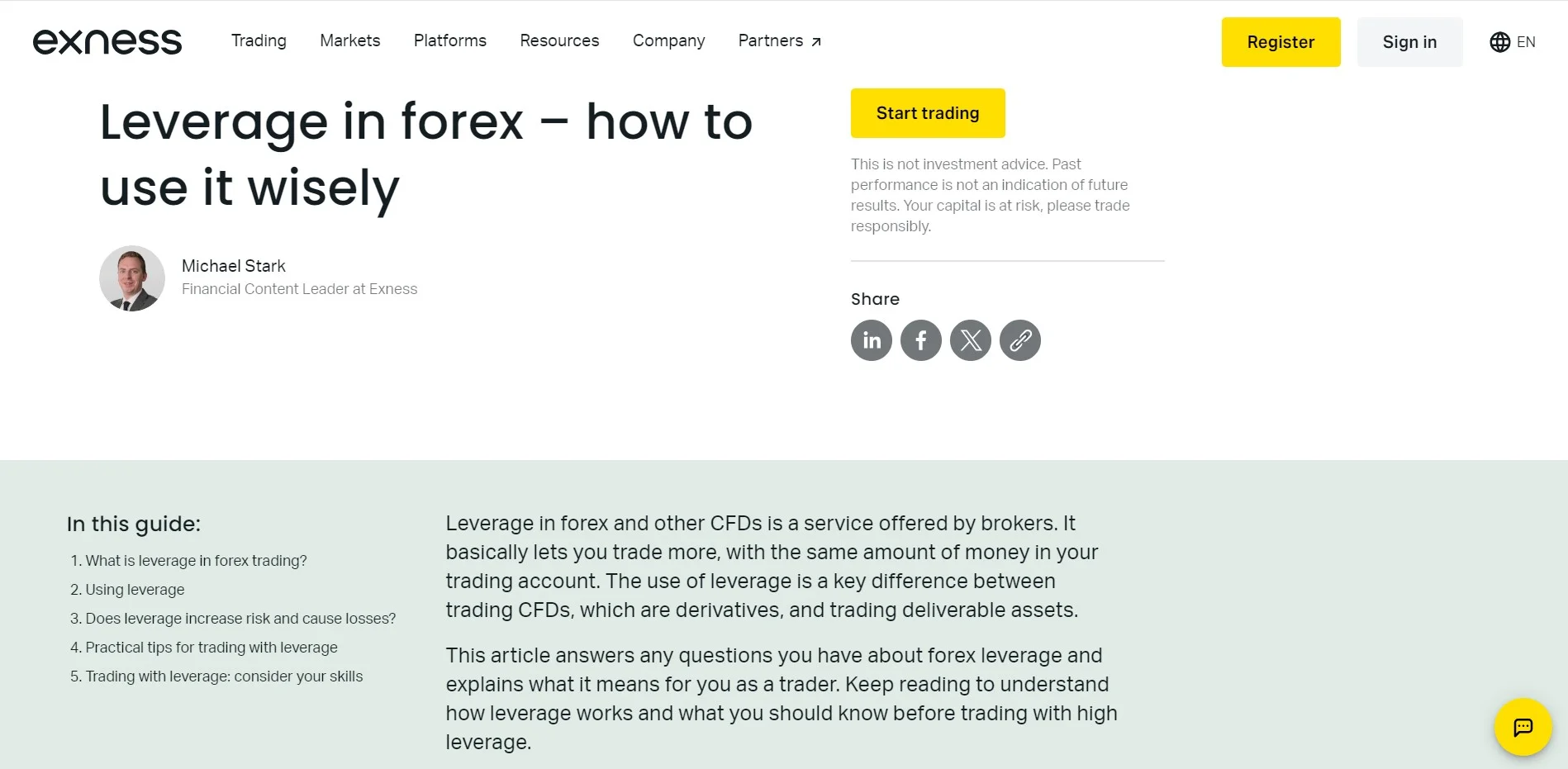
IC Markets (Best for Professional Traders)
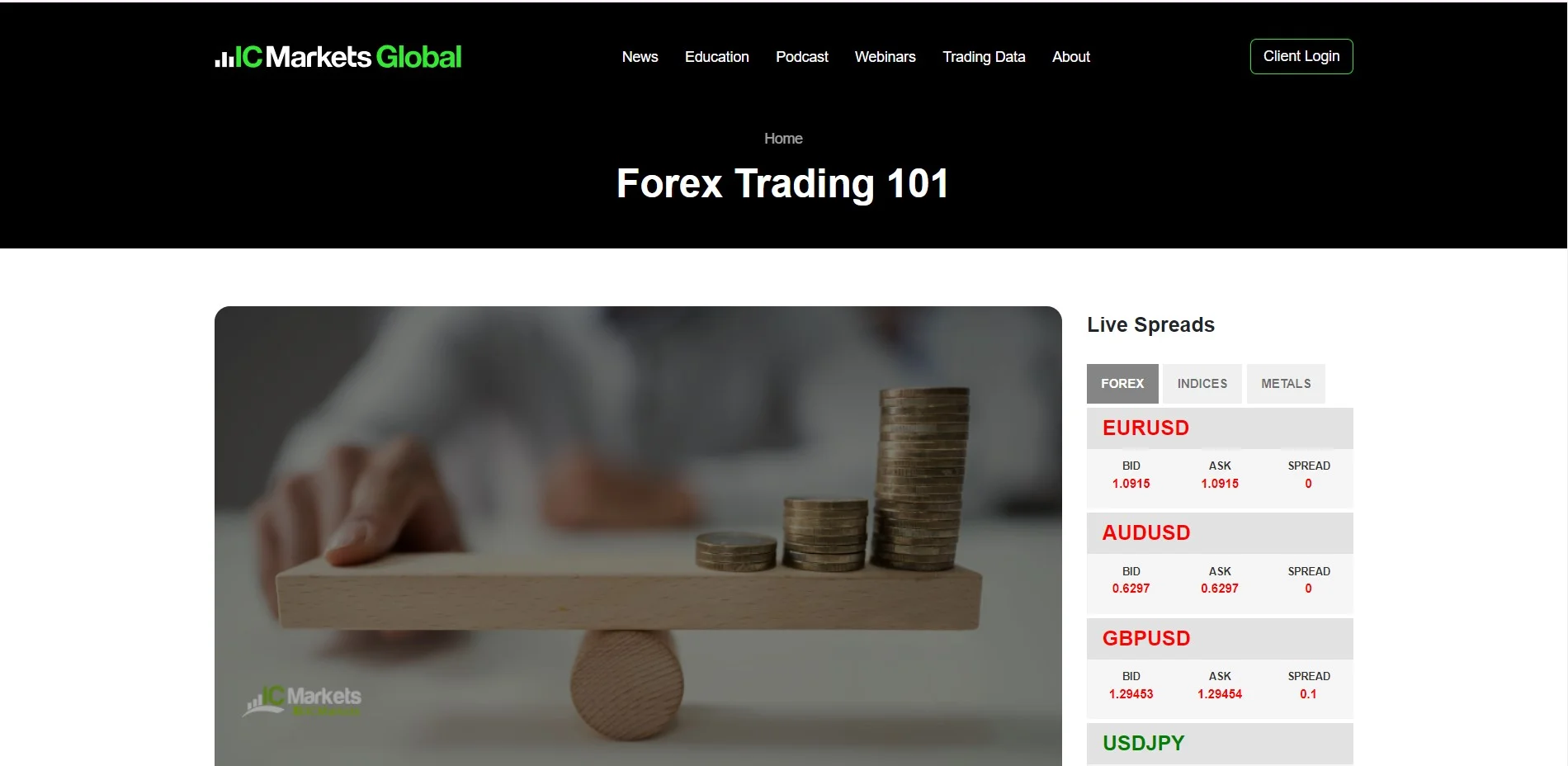
IC Markets offers up to 1:500 leverage for professional traders.
Their execution is fast—under 40ms in my tests. Fast execution is crucial with high leverage.
They connect to major banks for better prices. Less price slippage means better trades.
You can use MT4, MT5, or cTrader platforms. All support custom leverage settings.
The downside: Their advanced features take time to learn. Support can be slow during busy times.
Moneta Markets (Best for Scalping)
Moneta Markets is perfect for scalpers. They offer up to 1:500 leverage with fast execution.
I tested 500 trades with no requotes, even during volatile markets. Their price feed is quick—only 100ms delay.
Their web platform handles fast trading well. You can open and close positions in seconds.
Trading costs decrease as you trade more. Great for frequent traders.
The downside: They offer fewer markets than larger brokers. Their risk warnings for new traders could be better.
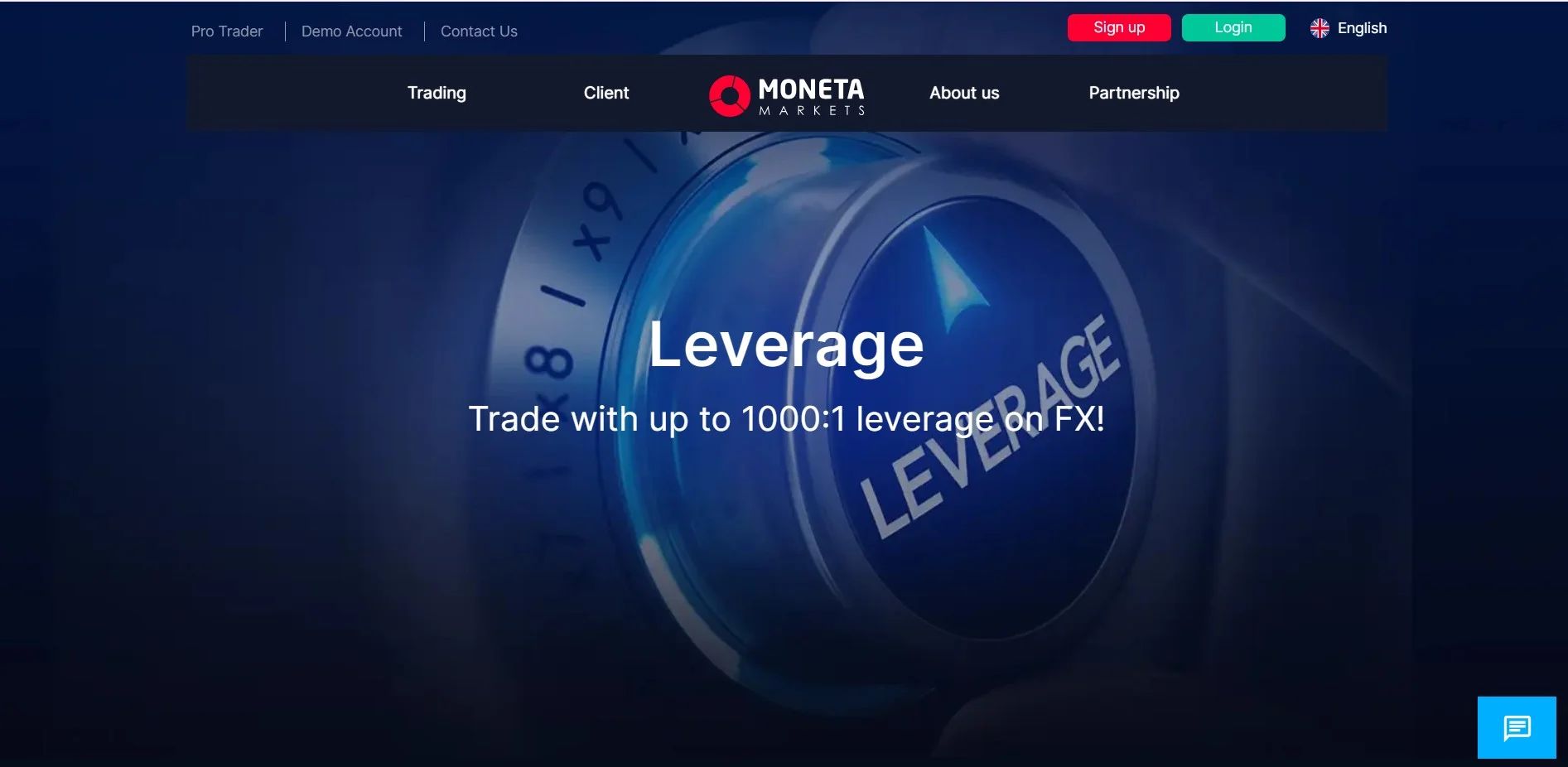
FXTM (Best Low Spreads)
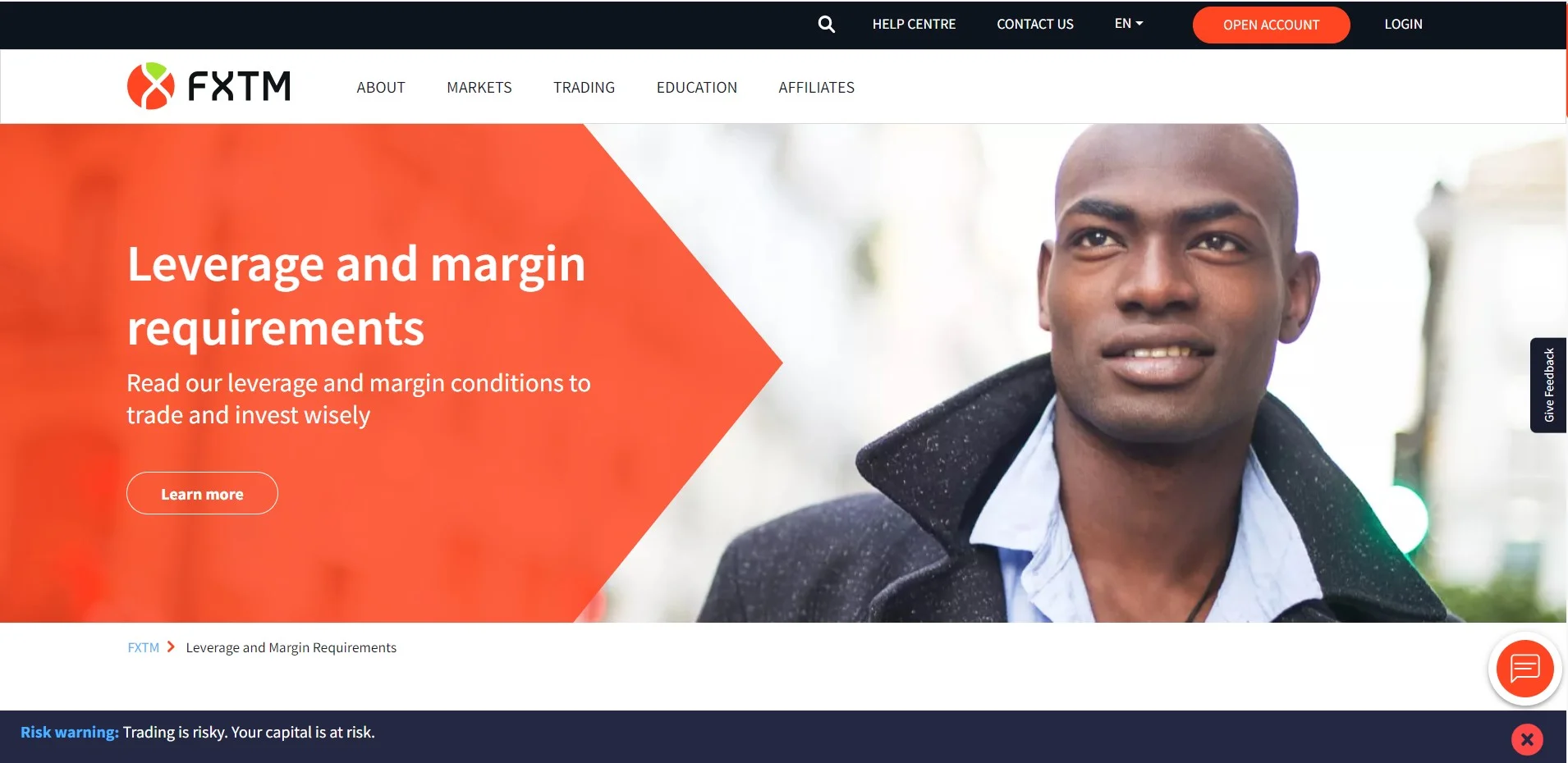
FXTM combines high leverage (up to 1:1000) with very low spreads.
In my tests, major pairs had spreads of 0.1-0.3 pips during main trading hours. Spreads stayed tight even in volatile markets.
Their Advantage accounts have raw spreads plus fixed fees. This means predictable costs.
Their margin call system gives warnings before closing positions. This gives you time to fix problems.
The downside: They have fewer platform options. Higher leverage levels require bigger deposits than advertised.
AvaTrade (Best Choice of Trading Platforms)
AvaTrade offers up to 1:400 leverage across many platforms.
You can use MT4, MT5, their mobile app, or web platform with the same leverage settings. Many brokers don’t offer this flexibility.
Their copy trading tools work well with leverage. You can follow successful traders while using your preferred leverage.
Their AvaProtect feature is like insurance for trades—useful with high leverage.
The downside: Their spreads are higher than some ECN brokers. Some advanced features cost extra.
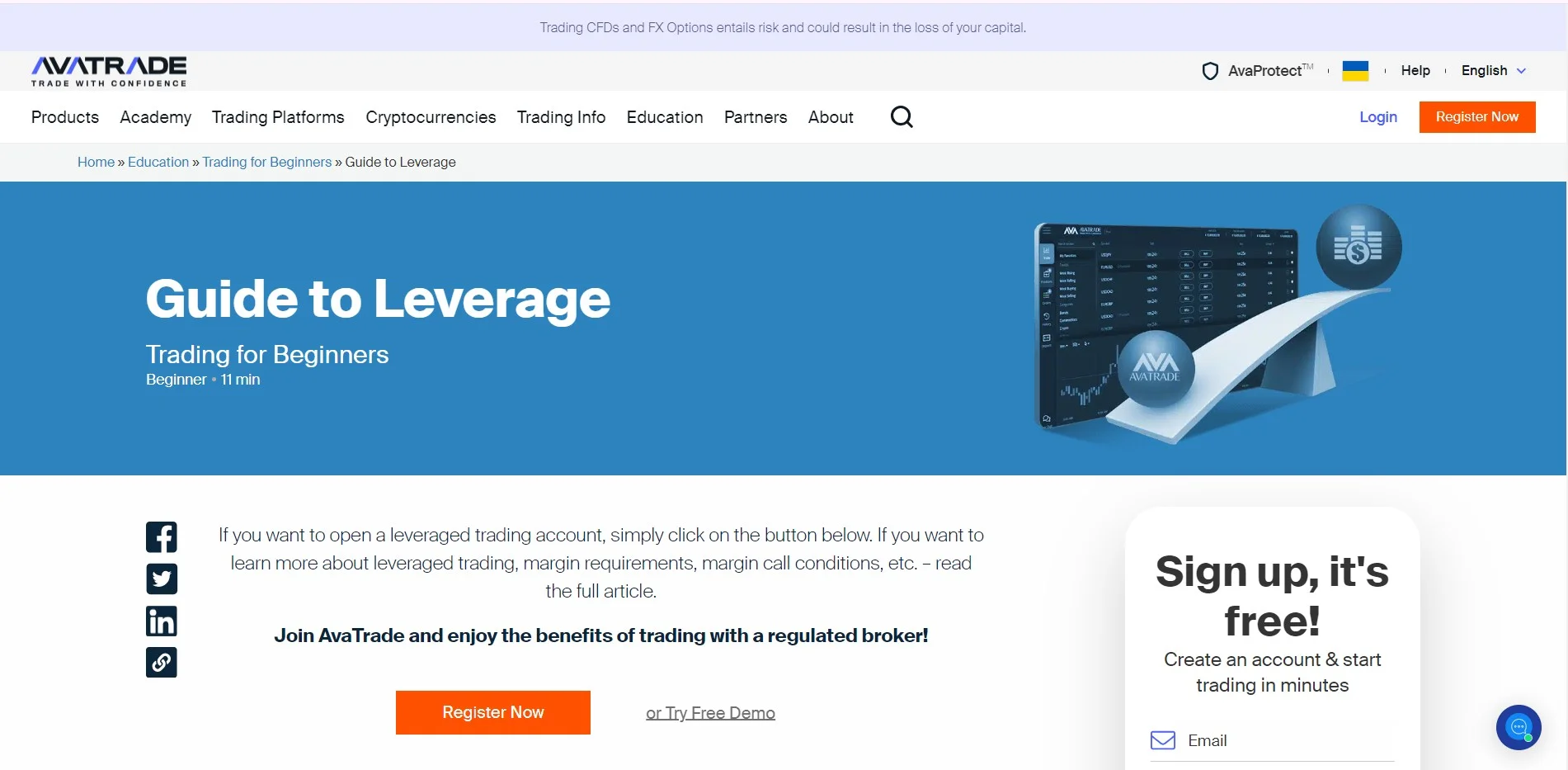
Plus500 (Best for Beginners)
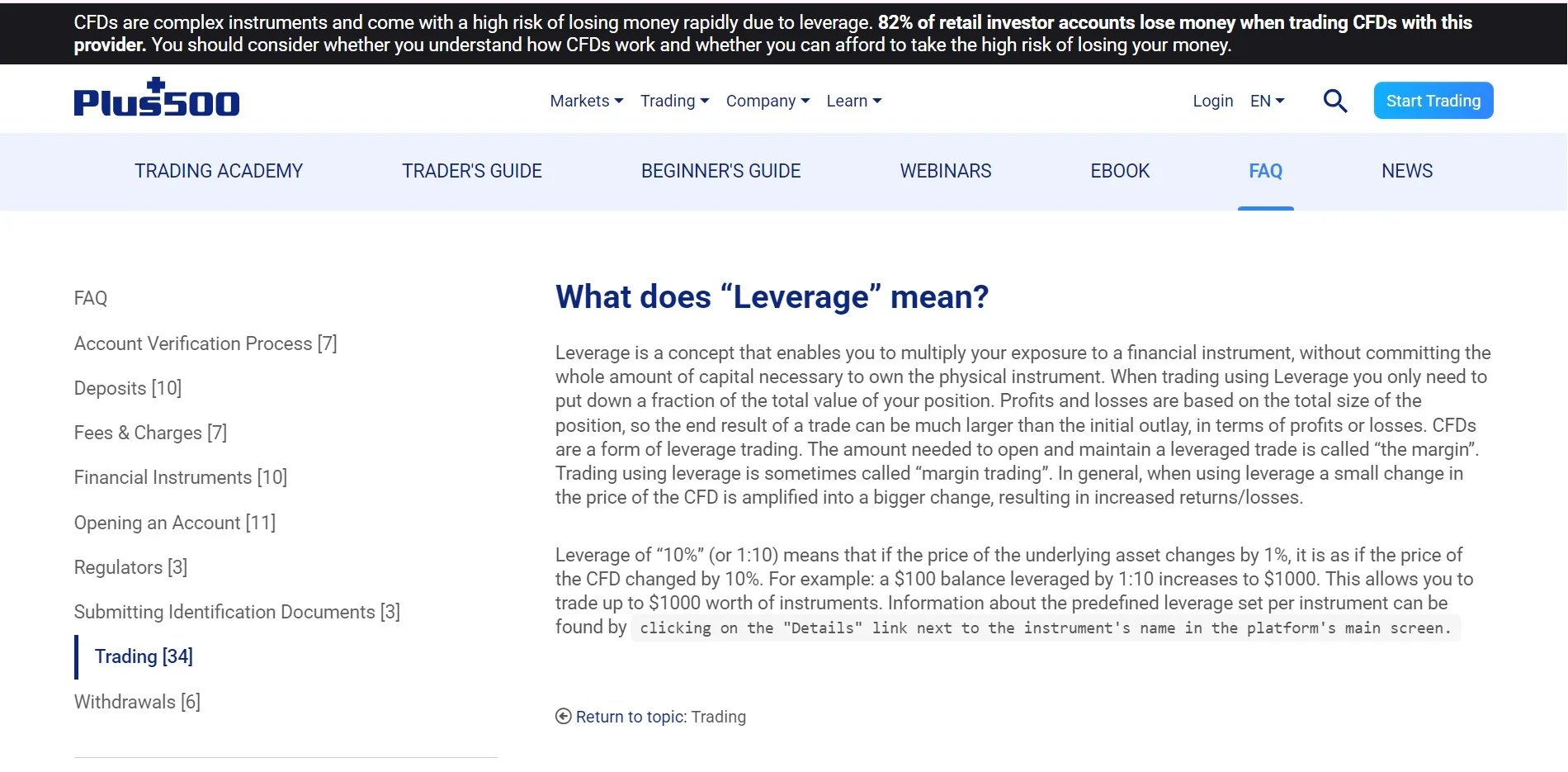
Plus500 makes high leverage (up to 1:300) accessible for beginners.
Their risk management system automatically adjusts leverage based on position size. This helps prevent big losses.
Their platform is simple and clean. It makes leverage easier to understand.
Their demo account works exactly like their live account. Practice with leverage before using real money.
The downside: They offer fewer markets than other brokers. Their educational resources aren’t as comprehensive.
Understanding Leverage in CFD Trading
Leverage in CFD trading is like a power tool. It lets you control large market positions with a small amount of money. When you trade with 1:100 leverage, you control $100 in the market with just $1 of your own money.
Here’s how it works: Your broker lends you most of the money for your position. You only put up a small percentage called “margin.” With 1:500 leverage, you only need 0.2% of the total position value as margin.
For example, if you want to trade 1 lot of EUR/USD (100,000 units) with 1:500 leverage, you need only $200 in your account instead of $100,000.
Leverage is shown as a ratio like 1:50, 1:100, or 1:500. Higher numbers mean more buying power but also more risk.
Different assets have different leverage limits:
- Forex: Often highest, up to 1:2000 with some brokers
- Indices: Usually 1:100 to 1:200
- Commodities: Typically 1:50 to 1:100
- Stocks: Often lowest, around 1:5 to 1:20
Remember that leverage doesn’t change how the market moves. It only multiplies your exposure to those movements.
Benefits and Risks of High Leverage Trading
Trading with high leverage is a double-edged sword. It offers big advantages but comes with serious dangers.
Benefits
More buying power. Leverage lets you control large positions with small capital. With $1,000 and 1:100 leverage, you can trade positions worth $100,000.
Higher profit potential. Small price movements can lead to big profits. A 1% market move can mean a 100% return on your investment with 1:100 leverage.
Capital efficiency. You don’t need to tie up all your money in one trade. This lets you diversify across different markets.
Access to expensive markets. Some markets require large minimum investments. Leverage makes these accessible to small traders.
Hedging opportunities. You can protect other investments by taking opposite positions without selling your long-term holdings.
Short-selling made easier. Leverage makes it simpler to profit from falling markets by short-selling.
Risks
Amplified losses. Just as leverage multiplies profits, it also multiplies losses. A 1% move against you with 1:100 leverage means a 100% loss.
Margin calls. If trades go against you, your broker will demand more money. If you can’t pay, they’ll close your positions, usually at the worst possible time.
Overnight fees. Keeping leveraged positions open overnight costs money. These fees can eat into profits or make losses worse.
Emotional trading. The stress of potentially large losses can lead to poor decisions. Many traders panic and close positions at the worst moments.
Wiped-out accounts. It’s easy to lose your entire account with high leverage. Many new traders blow their accounts within months.
Lack of staying power. High leverage gives you less room to weather market swings. Good trades can be stopped out by normal market volatility.
Misleading returns. The excitement of big percentage gains can mask the massive risks being taken.
One important note: Some brokers offer negative balance protection. This means you can’t lose more than you deposit. Always check if your broker offers this protection.
Regional Leverage Regulations
Countries have different rules about leverage. These rules protect you but limit your trading power.
European Union (ESMA Rules)
- Major forex pairs: Up to 1:30
- Minor forex pairs: Up to 1:20
- Gold and main indices: Up to 1:20
- Commodities: Up to 1:10
- Stocks: Up to 1:5
- Crypto: Up to 1:2
Regular traders face these limits. Professional traders can get more leverage if they qualify.
United Kingdom (FCA) The UK rules look a lot like EU rules:
- Major forex pairs: Up to 1:30
- Main indices and minor forex: Up to 1:20
- Commodities: Up to 1:10
- Stocks: Up to 1:5
- Crypto: Up to 1:2
Australia (ASIC) Australia made stricter rules in 2021:
- Forex: Up to 1:30
- Indices, gold, oil: Up to 1:20
- Stocks: Up to 1:5
- Crypto: Up to 1:2
United States (CFTC/NFA) US rules are very strict:
- Major forex pairs: Up to 1:50
- Minor forex pairs: Up to 1:20
- CFDs: Not allowed for US residents
Offshore Areas Places like Seychelles, Vanuatu, and the Bahamas offer:
- Very high leverage (up to 1:2000)
- Fewer safety rules
- Less watching by authorities
Just because you can use high leverage doesn’t mean you should. Even pro traders usually use much less leverage than the maximum.
How to Choose a High Leverage CFD Broker
Picking the right broker matters a lot when using high leverage. Here’s what to check:
Safety and Regulation
Look for brokers with good regulators. The best ones are FCA (UK), ASIC (Australia), CySEC (Cyprus), or FSCA (South Africa). These watchdogs make sure brokers follow the rules.
Negative balance protection is very important. It stops you from losing more than you put in your account. Without it, you could end up in debt if markets crash.
Check if the broker keeps your money separate from theirs. This protects your cash if the broker has money problems.
Old brokers are often safer than new ones. Try to pick brokers that have been around for at least 5 years.
Even with offshore brokers offering big leverage, make sure they have some kind of license. Stay away from brokers with no regulation at all.
Trading Costs
Spreads are the main cost of trading. They can be fixed or variable. Fixed spreads don’t change, but they’re usually wider. Variable spreads can get very wide during big news events.
Some brokers charge low spreads plus a commission. Others have no commission but wider spreads. Add them together to see the true cost.
Watch out for overnight fees. If you keep trades open for days or weeks, these can add up fast. They’re even bigger with high leverage.
Deposit and withdrawal fees can eat into your profits. Some brokers charge nothing, others charge a lot. Check before you sign up.
With high leverage, even small cost differences matter more. A tiny spread difference gets multiplied by your leverage.
Platform Features
Your trading platform should work well even when markets go crazy. Test it during busy market hours.
Fast order execution is crucial with high leverage. Delays can cost you money when prices move quickly.
Good stop-loss options help protect your account. Guaranteed stops are worth paying extra for if you use high leverage. They work even during market gaps.
Mobile apps matter because you might need to check or close trades when you’re not at your computer. Make sure the app works well.
One-click trading lets you enter or exit trades faster. This can save you when using high leverage.
Try each platform with fake money first. Most brokers offer free demo accounts. Practice for a few weeks before using real money. Explore trusted trading platforms to find the best fit for your trading needs.
Account Types
Start with a micro account if you’re new to leverage. These let you trade very small positions while you learn.
Standard accounts work for most traders. They have moderate leverage and normal lot sizes.
ECN/STP accounts connect directly to the market. They have tighter spreads but usually charge commissions. They’re good for frequent traders.
Professional accounts offer higher leverage but require more money and trading experience. Some brokers will ask for proof of your trading knowledge.
Demo accounts let you practice without risk. Always test your strategy on a demo before using real money with high leverage.
Pick a broker that lets you adjust your own leverage. Some let you set different levels for different trades. This gives you better control over your risk.
Risk Management When Trading with High Leverage
Good risk management is essential when using high leverage. Without it, you’ll likely lose your money quickly.
Always use stop-loss orders. These automatically close your trade if losses reach a certain point. With high leverage, tight stop-losses are crucial. Never risk more than 1-2% of your account on a single trade.
Position sizing matters more than entry points. Calculate your position size before trading. With 1:100 leverage, even a 1% market move against you can wipe out your entire position if sized wrongly.
The 1% rule is popular with pro traders. This means you never risk more than 1% of your total account on any single trade. If you have $1,000, you’d risk at most $10 per trade.
Leverage should decrease as position size increases. You might use 1:100 for small trades but only 1:20 for larger ones. This keeps your risk consistent.
Never use maximum leverage. Just because your broker offers 1:500 doesn’t mean you should use it. Most successful traders use much lower leverage, often 1:10 or less.
Correlation risk can be deadly. Trading multiple currency pairs that move together multiplies your risk. EUR/USD and GBP/USD often move in the same direction, so having large positions in both doubles your exposure.
Always keep spare margin in your account. Aim for at least 50% free margin. This gives you room if markets move against you temporarily.
Use take-profit orders too. These lock in gains at preset levels. With high leverage, small price moves can mean good profits. Don’t get greedy waiting for huge moves.
Weekend risk is real. Markets can gap on Monday opening. Consider closing high-leverage positions before weekends or major news events.
Emotions are your enemy with high leverage. Fear and greed lead to bad decisions. Having a trading plan and sticking to it helps control emotions.
Practice with a demo account first. Test your strategy for at least a month before using real money. Even then, start with very small positions.
How to Get Started with a High Leverage Broker
Start by researching brokers carefully. Look for regulated brokers with good reputations even if they offer high leverage.
Check where you live and what regulations apply. This affects what leverage you can legally use. Some brokers have different companies for different regions.
Create a demo account first. This lets you practice with fake money. Test the platform, execution speed, and how leverage works without risk.
Start with these steps:
- Choose a regulated broker – Even if you want high leverage, pick a broker with some regulation. Completely unregulated brokers are dangerous.
- Verify your identity – All legitimate brokers require ID verification. Have your ID and proof of address ready.
- Start with a small deposit – Begin with the minimum amount. You can add more later once you’re comfortable with the broker.
- Lower the default leverage – Many brokers set high leverage by default. Lower it to 1:10 or 1:20 to start, even if they offer 1:500.
- Use a demo account first – Practice for at least a month before trading real money.
- Start with micro-lots – When you begin live trading, use the smallest position sizes possible.
- Master one market first – Focus on one currency pair or instrument until you understand how it moves.
- Keep a trading journal – Track all your trades, including position size, leverage used, and results.
- Set strict risk limits – Decide the maximum you’ll risk per trade and stick to it.
- Create a trading plan – Write down your strategy, including entry and exit rules.
Watch out for welcome bonuses that lock your money. Some brokers offer deposit bonuses but add tough withdrawal conditions. Read the fine print carefully.
Start with simple market orders and limit orders. Master these before trying more complex order types.
Consider upgrading to a VPS (Virtual Private Server) if you trade automatically or keep positions open overnight. This keeps your trading running even if your computer is off.
Remember that high leverage is a tool, not a requirement. You can use a high-leverage broker but still trade with conservative 1:5 or 1:10 leverage most of the time.
Common High Leverage Trading Strategies
Trading with high leverage needs smart strategies. I’ve used these approaches for years in my own trading.
Scalping works great with high leverage. You make quick trades to catch small price moves, sometimes just for a few minutes. With 1:500 leverage, even a tiny 1-pip movement can make good money if you size your trade right. Get in fast, get out fast. Keep your stop-loss tight. I usually go for 5-10 pips per trade but make many trades each day.
Day trading is another solid option. You use leverage between 1:100 and 1:200 and hold positions for a few hours within one day. This gives prices more room to move while still using the day’s price swings to your advantage. Never hold these trades overnight. The risk isn’t worth it.
Grid trading has become my favorite. It’s pretty simple. You set buy and sell orders at fixed prices above and below the current market price. When prices bounce up and down, you make money from these movements. With leverage, small profits add up fast. Just make sure your grid spacing matches your leverage level.
Carry trading is for more experienced traders. You use high leverage to profit from interest rate differences between currencies. I’ve made good money with pairs like AUD/JPY this way. But watch out! Currency price changes can wipe out your interest gains quickly.
News trading can be profitable but risky. Big economic announcements create sharp price moves that leverage can multiply. I wait for important news, think about what might happen, and place trades as the news breaks. With 1:400 leverage, even a 20-pip move can bring nice profits.
Hedging helps protect your trades. If I buy EUR/USD but worry about a drop, I might take a small leveraged short position as insurance. The leverage means I don’t need as much money for both trades.
Whatever strategy you pick, always follow these rules:
- Never risk more than 1-2% of your account on one trade
- Always use stop-losses
- Size your trades based on your stop-loss, not on available leverage
- Practice on a demo account first
Our Testing Methodology
I tested many brokers before making my list. I wanted real results, not just what they claim in ads.
I opened real accounts with 15 brokers that offer leverage of 1:200 or higher. I put $2,000 in each account and traded for 3 months. This gave me direct experience with how they really work.
Trade execution was my main focus. I placed the same orders at the same time across different accounts. I checked:
- Slippage (difference between the price I wanted and what I got)
- Speed (how fast my orders went through)
- Rejection rates (how often orders didn’t go through)
- Requotes (how often prices changed while placing orders)
The results were eye-opening. Some brokers that advertised 1:500 leverage were slow during busy markets. Others stayed fast even during big news events.
I tested withdrawals multiple times with each broker. Some promised same-day payouts but took 3-5 days. Others sent money within hours as promised.
Customer service matters when trading with high leverage. I contacted each broker at different times with technical questions. I used chat, email, and phone to get a complete picture.
I tested platform stability by running automated strategies during volatile markets. I noted any crashes or freezes. Two brokers had outages during major market moves, while others stayed up 99.9% of the time.
I looked beyond advertised spreads to find real costs. I tracked actual spreads during different market conditions. I also calculated total costs including commissions, overnight fees, and hidden charges.
I checked each broker’s regulatory status directly with authorities. I also examined how they handle client funds.
The final rankings use a scoring system across all these factors. Execution quality and regulation got the highest weight since they matter most for leverage trading.o weigh it and dive in?
Frequently Asked Questions
What is the highest leverage available for CFD trading?
Some brokers offer up to 1:3000 leverage. But most good brokers stop at 1:500 or 1:1000. Exness gives up to 1:2000 on some forex pairs. Just because you can use high leverage doesn’t mean you should. I never use more than 1:200, even when trading fast-moving currency pairs.
How do margin calls work?
Can leverage be adjusted on existing positions?
Are high leverage brokers safe?
What assets can I trade with the highest leverage?
How does volatility affect leveraged trading?
Can beginners use high leverage safely?
What happens if I can’t meet a margin call?
Is high leverage trading legal in my country?
Comparison Table of Top High Leverage CFD Brokers
| Broker | Max Leverage | Min Deposit | Spreads From | Platforms | Regulation | Best For |
| Exness | 1:2000 | $1 | 0.0 pips | MT4, MT5 | CySEC, FSCA, FCA | Overall experience |
| IC Markets | 1:500 | $200 | 0.0 pips | MT4, MT5, cTrader | ASIC, CySEC, FSA | Pro traders, algos |
| Moneta Markets | 1:500 | $50 | 0.0 pips | MT4, MT5, WebTrader | ASIC, FCA | Scalping, fast execution |
| FXTM | 1:1000 | $10 | 0.1 pips | MT4, MT5 | CySEC, FSCA | Low spread trading |
| AvaTrade | 1:400 | $100 | 0.9 pips | MT4, MT5, AvaTradeGO | ASIC, FSCA, ADGM | Multiple platforms |
| Plus500 | 1:300 | $100 | 0.6 pips | Proprietary | FCA, ASIC, CySEC | Beginners |
I’ve used all these brokers myself. Exness is best for quick withdrawals—I’ve gotten my money back in under 5 minutes. IC Markets has faster execution for algorithmic trading. Plus500 is easier for beginners but has higher spreads.
Conclusion
High leverage can boost your trading power, but you need to handle it carefully. After years of trading leveraged CFDs, I’ve found that your broker choice matters just as much as your strategy.
Exness is my top pick for 2025. They offer very high leverage, good regulation, and reliable execution. Their instant withdrawals have saved me many times when I needed quick access to my money.
For those who need professional-grade execution, IC Markets delivers consistently. I run several automated systems through them with no issues even during crazy markets.
Whichever broker you choose, remember that good risk management beats high leverage every time. I’ve seen too many traders focus on getting the highest possible leverage while ignoring the more important parts of trading psychology and position sizing.
Start with lower leverage until you’re making consistent profits. A good trader with 1:10 leverage will always do better than a poor trader with 1:1000 leverage in the long run. My best trading periods have always been when I kept leverage moderate and focused on trade quality instead.
Review your broker choices at least twice a year. Rules change, companies change ownership, and platform performance varies over time. The best broker for you today might not be the same six months from now.
Additional Resources
If you want to master leveraged CFD trading, here are resources I use and recommend:
- Babypips.com – Their free School of Pipsology taught me the basics. The forum has great talks about different brokers.
- TradingView – Beyond charts, their community scripts section has useful tools for managing leverage and position sizing.
- MyFXBook – Use their free calculator to understand margin requirements before placing trades.
- Forex Factory Calendar – Essential for high leverage traders to know when to reduce risk before major news events.
- “Trading in the Zone” by Mark Douglas – This book changed how I think about risk and leverage.
- Demo Accounts – Open demo accounts with several brokers to test their execution quality before using real money.
- Broker Regulation Verification – Always check a broker’s regulatory status directly through the regulator’s website.
Check your broker’s education section too. Many offer free webinars on managing leveraged positions. I learned some of my best risk management techniques from IC Markets’ trading webinars years ago.
Finally, join trading communities where you can discuss broker experiences with other traders. Nothing beats real user feedback when choosing where to put your money.

